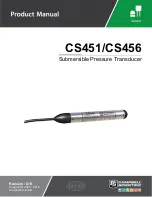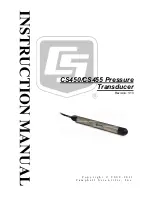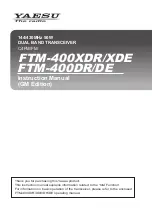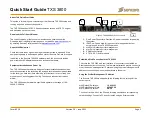
2 6 6 DDS H A RT |
P R E SSU R E T R A N SM I T T ER S | O I/ 2 6 6 D DS - EN R E V. B
19
. . .5 Transmitter wiring
Wiring procedure
Follow these steps to wire the transmitter:
• Remove the temporary plastic cap from one of the two electrical connection ports located at both sides in the upper part of
the transmitter housing.
• These connection ports may have a 1/2 inch internal NPT-F or M20 threads. Various adaptors and bushings can be fitted to
these threads to comply with plant wiring (conduit) standards.
• Remove the housing cover of the “field terminals” side. See the indication on housing. In an Explosion-Proof/Flame-Proof
installation, do not remove the transmitter covers when power is applied to the unit.
• Run the cable through the cable gland and the open port.
• Connect the positive lead to the + terminal, and the negative lead to the – terminal.
• If applicable, install wiring with a drip loop. Arrange the drip loop so the bottom is lower than the conduit connections and the
transmitter housing.
• Before reassembling covers, the integrity of the cover O-rings must be checked. If damaged they must be replaced with an
original spare part. A slight grease layer should be applied for proper lubrication.
• Put back the housing cover, turn it to seat O-ring into the housing and then continue to hand tighten until the cover contacts
the housing metal-to-metal. In Ex-d (Explosion Proof) installation, lock the cover rotation by turning the set nut (use the 2mm
Allen key supplied with the instrument).
• Plug and seal the electrical ports. Make sure that when the installation has been completed, the electrical ports are properly
sealed against entry of rain and/or corrosive vapors and gases.
Grounding
Pressure transmitter housing should be grounded or earthed in accordance with national and local electrical codes. Ground
connection is mandatory for surge protector equipped devices in order to ensure proper functioning.
Protective grounding terminals (PE) are available outside and/or inside the housing of the transmitter. Both ground terminals are
electrically connected and it is up to the user to decide which one to use. The most effective transmitter case grounding method
is direct connection to earth ground with impedance equal to or less than 5 ohm.
Figure 15 - Ground connection on transmitter housing
Surge protector equipped terminal block (optional)
The pressure transmitter housing with surge protector (ordering code digit S2) inside the terminal board must be connected using
the grounding terminal (PE), by means of a short connection with the equipotential bonding. Equipotential bonding conductor
must have 4.00mm2 of maximum cross-section.
Test voltage withstand capability can no longer be ensured when this protective circuit is used.
IMPORTANT
Summary of Contents for 266 DDS
Page 30: ...Device Set up 30 266 DDS HART PRESSURE TR ANSMITTERS OI 266DDS EN REV B ...
Page 31: ...266 DDS HART PRESSURE TR ANSMITTERS OI 266DDS EN REV B 31 ...
Page 32: ...32 266 DDS HART PRESSURE TR ANSMITTERS OI 266DDS EN REV B ...
Page 33: ...266 DDS HART PRESSURE TR ANSMITTERS OI 266DDS EN REV B 33 ...
Page 34: ...Display 34 266 DDS HART PRESSURE TR ANSMITTERS OI 266DDS EN REV B ...
Page 35: ...266 DDS HART PRESSURE TR ANSMITTERS OI 266DDS EN REV B 35 ...
Page 36: ...36 266 DDS HART PRESSURE TR ANSMITTERS OI 266DDS EN REV B ...
Page 41: ...Device Info 266 DDS HART PRESSURE TR ANSMITTERS OI 266DDS EN REV B 41 ...
Page 42: ...Communication 42 266 DDS HART PRESSURE TR ANSMITTERS OI 266DDS EN REV B ...
Page 59: ...266 DDS HART PRESSURE TR ANSMITTERS OI 266DDS EN REV B 59 Notes ...
















































